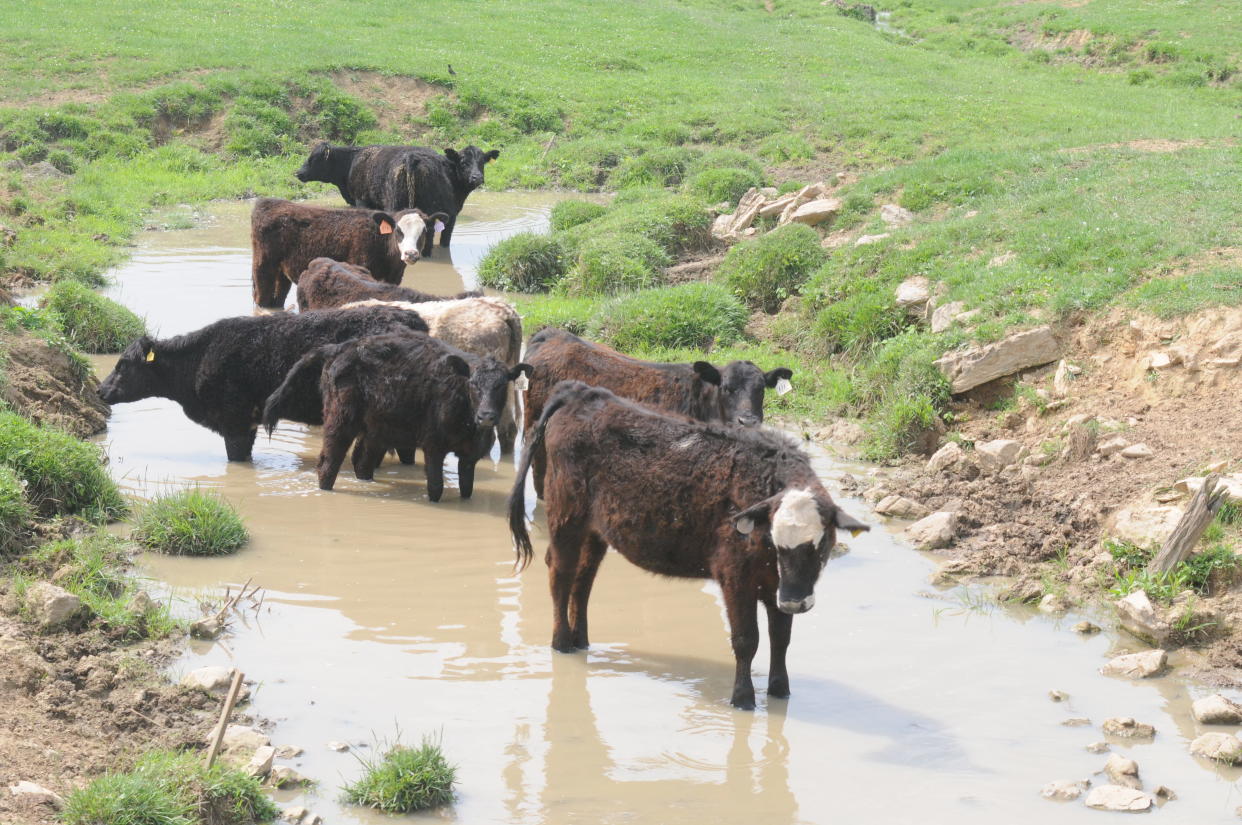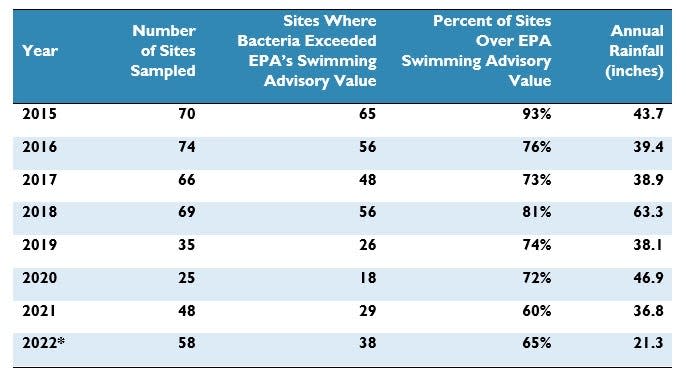Think twice before swimming in Shenandoah waterways — they're full of fecal bacteria

Washington, D.C. — Do you want to know what's in a large majority of the waterways in the Shenandoah Valley? Poop — and a lot of it apparently.
About three quarters of Virginia’s water monitoring stations in the Shenandoah Valley found levels of fecal bacteria so high in the first half of 2022 that they exceeded EPA recommendations for warning people about the health risks of swimming or splashing in the water.
Seventy-six percent of Virginia Department of Environmental Quality sampling locations (44 of 58) in Shenandoah waterways from Jan. 1 through July 12 of this year (the most recent available data) had levels of E. coli that were unsafe for swimming or recreation, according to an analysis of state monitoring numbers by the nonprofit Environmental Integrity Project. In 2021, 60% (29 of 48) of the water monitoring stations in the Valley did not meet the standard.
Both the first half of 2022, and all of 2021, had lower bacteria numbers than the average for 2015 to 2020, when almost 80% of samples had unhealthy levels of bacteria. Lower rainfall levels in 2021 may have temporarily reduced the runoff of manure and other pollutants that drive up bacteria levels in rivers and streams.
“The bacteria levels in the Shenandoah River are still too high, and Virginia needs to do more to encourage — or require — streamside livestock fencing and prevent the chronic over application of manure to farm fields,” said Eric Schaeffer, executive director of the Environmental Integrity Project. “The Shenandoah Valley is a treasure that deserves better protections. We do recognize that Virginia is taking steps to increase funding for farm best management practices, including by adding streamside fencing, and that deserves praise.”
In March, the Virginia General Assembly approved a record $265 million for fiscal years 2023 and 2024 for farm pollution-control best management practices — including streamside livestock fencing and other steps to reduce runoff into waterways.
Despite the persistently high bacteria levels in the Shenandoah, Virginia has posted no signs warning rafters, kayakers or swimmers about bacteria levels — as it does regularly with swimming advisories on ocean beaches with high bacteria levels, the Environmental Integrity Project reported. The EPA recommends warning swimmers when concentrations of E. coli bacteria exceed 235 colony forming units per 100 milliliters of water.

Saltwater vs. freshwater bacteria levels and public safety warnings
The Virginia Department of Health does conduct bacteria monitoring in saltwater beach swimming areas of Virginia, and it issues swimming warnings for bacteria in those areas (like in Virginia Beach, for example.)
"But because of budget limitations, VDH does not have the staff or resources to also monitor swimming and rafting areas in freshwater areas of the state, like the Shenandoah River and its tributaries," said Tom Pelton, director of communications at the Environmental Integrity Project.
In 2018, VDH applied for $200,000 in funding to be able to monitor the freshwater swimming areas of the state, but the General Assembly turned them down, according to the EIP.
Instead, in these freshwater areas, the Virginia Department of Environmental Quality does the water quality monitoring in the freshwater parts of the state but VDEQ does not issue bacteria warnings for swimmers, explained Pelton.
The Environmental Integrity Project uses EPA’s recommended level of E coli bacteria that should trigger a health threat warning to people swimming or tubing or rafting in the waterways, even though Virginia does not issue these warnings in freshwater parts of the state.
"We have complained in past reports that it’s unfair to middle class and working class people in the Shenandoah Valley that they don’t have the same level of health protections as perhaps the tourists who have condos on saltwater beaches like Virginia Beach," said Pelton.
Last year, the Environmental Integrity Project released — and submitted to the state — a report on just this subject: the lack of adequate monitoring and warnings for freshwater parts of the state, including the Shenandoah Valley.
Livestock manure and runoff into Valley streams
Almost 160 million chickens, 16 million turkeys and 528,000 cows are raised annually in the Shenandoah Valley’s Augusta, Page, Shenandoah and Rockingham counties. Most of their manure is spread on surrounding farmland as fertilizer, but it contains far more phosphorus than crops need for growth, the EIP said. The excess manure leaks pollutants into groundwater and is often washed by rain into surrounding streams.
Bacteria levels in waterways are known to increase after periods of heavy rainfall because rain flushes fertilizer and sediment into rivers and streams. Total rainfall in Harrisonburg, in the heart of the Shenandoah Valley, was significantly lower in 2021 (about 37 inches) than the annual average from 2015 to 2020 (46 inches). That lower rainfall in 2021 could have temporarily reduced bacteria levels that year, said the EIP. Complete numbers are not yet available for 2022.
In April 2019, the Environmental Integrity Project and the Shenandoah Riverkeeper released the study, Livestock Fencing in the Shenandoah Valley, that used aerial photographs of the livestock industry in to show that 81% of farms in the state’s two largest farming counties — Augusta and Rockingham — failed to fence their cattle out of streams, contributing to bacteria contamination.
This low fencing rate was despite a pledge by the state of Virginia to EPA that 95% of streams through pastures would have livestock fencing by 2025 to meet the goals of the state’s cleanup plan for the Chesapeake Bay.
The release of that April 2019 report spurred the Virginia Department of Conservation and Recreation to perform its own aerial survey of livestock fencing. Virginia lawmakers then approved increased funding and reimbursement rates to encourage more farmers to install streamside livestock fencing. Legislators also passed a law that allows state officials to mandate streamside livestock fencing if the agricultural sector fails to achieve Bay pollution reduction goals by 2025.
As a result of the increased funding, an increased number of farmers in Virginia started enrolling in a state program to install livestock fencing. In Augusta and Rockingham counties, the number of farmers signing up for the streamside fencing program grew from 26 in fiscal year 2019, to 38 in fiscal year 2020, to 55 in fiscal year 2021, and 40 in fiscal year 2022, according to data from the Virginia Department of Conservation and Recreation.
More: As Staunton teen fights for his life, a group of friends keeps vigil at the hospital
For more details about bacteria monitoring in the Shenandoah Valley, click here.
In October 2019, Virginia revoked its “beach action value” for E. coli in freshwater areas, which is a trigger value for potential health risks for people swimming or recreating in waters with more than 235 counts of E. coli/100 ml of water. The Commonwealth no longer has a beach warning value for freshwater areas like the Shenandoah River and issues no warnings when fecal bacteria levels are high in these areas.
However, despite Virginia’s change, EPA continues to recommend that states warn swimmers of potential health risks when E coli counts exceed 235 counts of E. coli/100 ml of water. So, the Environmental Integrity Project in its annual reporting on the issue uses this level of bacteria as a yardstick of potential threat for water contact recreation.
To examine an online map with details about Virginia’s bacteria monitoring results in locations up and down the Shenandoah Valley, and where it is safe to swim, click here.
The Environmental Integrity Project is a 20-year-old nonprofit organization, based in Washington D.C. and Austin, Texas, dedicated to the enforcement of environmental laws and the strengthening of policy to protect public health and the environment.
Special Report: We created scorching 'heat islands' in East Coast cities. Now they're becoming unlivable
More: Bears and Blankets moves into new space, creating cohesive early learning center
Questions? Reporter Monique Calello can be reached at mcalello@newsleader.com.
Your support is vital to local journalism. Please subscribe so we can keep writing stories you care about the most.
This article originally appeared on Staunton News Leader: Swimming in Shenandoah Valley discouraged due to high bacteria levels

